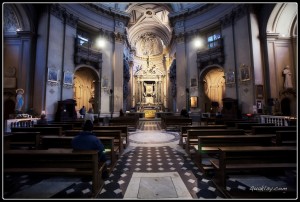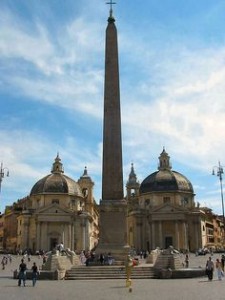 Small church erected by the Archconfraterniy of St. James of the Incurables in 1525. It no longer exists, disappeared during the emplacement of Rome before the city became the capital of Italy. You can see a topographical perspective in Carlo Losi’s plant, which is based on previous etchings of 1577. The image of the Virgin contained in it was moved to the twin church St. Mary of Miracles erected on the Piazza del Popolo, between Via del Corso and Via Ripetta, in 1664.
Small church erected by the Archconfraterniy of St. James of the Incurables in 1525. It no longer exists, disappeared during the emplacement of Rome before the city became the capital of Italy. You can see a topographical perspective in Carlo Losi’s plant, which is based on previous etchings of 1577. The image of the Virgin contained in it was moved to the twin church St. Mary of Miracles erected on the Piazza del Popolo, between Via del Corso and Via Ripetta, in 1664.
The presence of St. Camillus
Immediately after his priestly ordination in 1584, Camillus becomes chaplain of a small church called Madonna de’ Miracoli, placed near the Porta del Popolo, nominated by the “Guardian Lords” of the St. James Hospital, where Our Saint at that time occupies the role of Master of the House. Camillus and his companions move here, bringing with them the Crucifix, which twice had come to life to encourage the Charity’s Giant. The high humidity from the Tiber River that flows around the house sickens Camillus and his partner Curzio Lodi, causing them to seek medical treatment, Camillus at the St. James Hospital, Curzio at the St. John’s Hospital. Once healed, they return to the “Madonna”, where Norcino Bernardino has remained, the only in good health. Camillus and the two companions remain here for a little while, until December 1584, when they move to a more suitable housing in the vicinity of the Botteghe Oscure.
What remains
Important place for the birth and the beginning of the work of the Congregation just created by St. Camillus. Unfortunately there is no visible trace left of the small church located near Porta del Popolo.
To see
 St. Mary of Miracles: one of the twin churches of Piazza del Popolo. The origin of the construction of the church is a miracle occurred, according to tradition, on June 20, 1325, when a woman, near the Tiber, invoked an image of the Madonna painted on the walls along the river to save her baby fallen into the waters. The rescue of the child imposed the construction of a chapel dedicated to Mary.
St. Mary of Miracles: one of the twin churches of Piazza del Popolo. The origin of the construction of the church is a miracle occurred, according to tradition, on June 20, 1325, when a woman, near the Tiber, invoked an image of the Madonna painted on the walls along the river to save her baby fallen into the waters. The rescue of the child imposed the construction of a chapel dedicated to Mary.
Because of the increasingly insalubrity of the site along the Tiber and of the continual flooding of the river, in 1661 Pope Alexander VII ordered the building of a new church, where to keep the copy of the image of the Madonna of Miracles, and that this new building would replace an existing one dedicated to St. Orsola. The new church was begun, however, only 14 years after the order of the pope, in 1675, and 13 years after the founding of the so-called twin church of St. Mary in Montesanto
Nearby
Piazza del Popolo: one of the most famous squares of Rome, at the foot of the Pincio Hill. The shape of the squaretakes the presentstructure onlyatthe end ofthe nineteenth century. Previously it was a small square of trapezoidal shape, spreading towards the Trident (via del Babuino, via del Corso, via di Ripetta). At the time of Napoleon’s occupation, in fact, an architectural and urban planning of the square was revised by the neoclassical architect Giuseppe Valadier. Here are the church of Santa Maria del Popolo and the twin churches Saint Mary in Montesanto (1675) and Saint Mary of Miracles (1678). Also Porta del Popolo and the fountains, including the central one surmounted by a huge obelisk, deserve to be admired.ù
St. Mary in Montesanto: between Via del Corso and Via del Babuino. It is popularly known as the twin church of Saint Mary of Miracles, despite their considerable differences especially in the planimetric setting. The name of the church comes from the fact that it replaced a small church that belonged to the Carmelite friars of the province of Monte Santo in Sicily. It was built on the initiative of Pope Alexander VII in 1662, but the works were suspended due to the death of the pope in 1667; they restarted in 1673 under the supervision of Bernini and the collaboration of Carlo Fontana. The church was completed in 1679.
 From Termini Station take metro line A, get off at Spagna and continue on foot for 950m.
From Termini Station take metro line A, get off at Spagna and continue on foot for 950m.
From Tiburtina Station take metro line B, get off at Termini and take metro A, get off at Spagna and continue on foot for 95m.
Bus numbers 186, 628, 81, 87, 492, 70, 87, C3, and get off at the Ripetta stop.














Camillians on Facebook
Camillians on Twitter
Camillians on Instagram